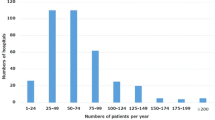Abstract
Background
Size of primary tumor has implications for staging, imaging, and treatment of pancreatic head carcinomas. Limited data suggest that small tumor size is associated with better survival. The objective of this population study is to analyze characteristics and survival of patients with resected pancreatic head ductal carcinomas sized <1 and 2 cm.
Methods
Analysis of resected invasive pancreatic head ductal carcinomas captured within SEER Program from 1998 to 2008.
Results
A total of 7,135 cases were analyzed with nodal metastases in 31, 55, and 67 % for subcentimeter, 1.1–2 cm, and >2 cm tumors, respectively. Median survival was longest for node-negative tumors (38, 26, 19 months for tumors measuring ≤1, 1.1–2, and >2 cm, respectively; p < 0.001) versus node-positive tumors (18, 19, 14 months, p < 0.001). In multivariate analysis, large tumor size was associated with higher risk of death (hazard ratio (HR) = 1.179 for tumors 1.1–2 cm, p = 0.152; HR = 1.665 for tumors >2 cm, p < 0.001).
Conclusions
Small pancreatic cancers have a poor prognosis and surprisingly high rate of nodal involvement; therefore, they cannot be considered early cancers. Size-based screening is unlikely to save lives with current treatment options.


Similar content being viewed by others
References
Brennan MF, Kattan MW, Klimstra D, et al. Prognostic nomogram for patients undergoing resection for adenocarcinoma of the pancreas. Ann Surg. 2004;240:293–8.
Brennan MF, Moccia RD, Klimstra D. Management of adenocarcinoma of the body and tail of the pancreas. Ann Surg. 1996;223:506–11. discussion 511-2.
Cameron JL, Crist DW, Sitzmann JV, et al. Factors influencing survival after pancreaticoduodenectomy for pancreatic cancer. Am J Surg. 1991;161:120–4. discussion 124-5.
Neoptolemos JP, Stocken DD, Friess H, et al. A randomized trial of chemoradiotherapy and chemotherapy after resection of pancreatic cancer. N Engl J Med. 2004;350:1200–10.
Haeno H, Gonen M, Davis MB, et al. Computational modeling of pancreatic cancer reveals kinetics of metastasis suggesting optimum treatment strategies. Cell. 2012;148:362–75.
Hruban RH, Goggins M, Parsons J, et al. Progression model for pancreatic cancer. Clin Cancer Res. 2000;6:2969–72.
Yachida S, Jones S, Bozic I, et al. Distant metastasis occurs late during the genetic evolution of pancreatic cancer. Nature. 2010;467:1114–7.
Rhim AD, Mirek ET, Aiello NM, et al. EMT and dissemination precede pancreatic tumor formation. Cell. 2012;148:349–61.
Al-Sukhni W, Borgida A, Rothenmund H, Holter S, Wilson S, Moore MJ, Narod S, Jhaveri K, Haider MA, Gallinger S. Screening for pancreatic cancer in a high-risk cohort: a 7-year experience. J Clin Oncol. 2011;29:4045.
Vasen HF, Wasser M, van Mil A, et al. Magnetic resonance imaging surveillance detects early-stage pancreatic cancer in carriers of a p16-Leiden mutation. Gastroenterology. 2011;140:850–6.
Chiang KC, Yeh CN, Lee WC, et al. Prognostic analysis of patients with pancreatic head adenocarcinoma less than 2 cm undergoing resection. World J Gastroenterol. 2009;15:4305–10.
Jung KW, Kim MH, Lee TY, et al. Clinicopathological aspects of 542 cases of pancreatic cancer: a special emphasis on small pancreatic cancer. J Korean Med Sci. 2007;22(Suppl):S79–85.
Ariyama J, Suyama M, Satoh K, et al. Imaging of small pancreatic ductal adenocarcinoma. Pancreas. 1998;16:396–401.
Ishikawa O, Ohigashi H, Imaoka S, et al. Minute carcinoma of the pancreas measuring 1 cm or less in diameter-collective review of Japanese case reports. Hepatogastroenterology. 1999;46:8–15.
Tsunoda T, Yamamoto Y, Kimoto M, et al. Staging and treatment for patients with pancreatic cancer. How small is an early pancreatic cancer? J Hepatobiliary Pancreat Surg. 1998;5:128–32.
Furukawa H, Okada S, Saisho H, et al. Clinicopathologic features of small pancreatic adenocarcinoma. A collective study. Cancer. 1996;78:986–90.
NCI. Surveillance, Epidemiology, and End Results (SEER) Program Limited-Use Data (1973–2008), National Cancer Institute, DCCPS, Surveillance Research Program, Cancer Statistics Branch, based on the November 2010 submission, 2011.
Nitecki SS, Sarr MG, Colby TV, et al. Long-term survival after resection for ductal adenocarcinoma of the pancreas. Is it really improving? Ann Surg. 1995;221:59–66.
Bilimoria KY, Bentrem DJ, Ko CY, et al. Validation of the 6(th) edition AJCC pancreatic cancer staging system: report from the National Cancer Database. Cancer. 2007;110:738–44.
Sohn TA, Yeo CJ, Cameron JL, et al. Intraductal papillary mucinous neoplasms of the pancreas: an updated experience. Ann Surg. 2004;239:788–97; discussion 797-9.
Hsu CC, Herman JM, Corsini MM, et al. Adjuvant chemoradiation for pancreatic adenocarcinoma: the Johns Hopkins Hospital–Mayo Clinic collaborative study. Ann Surg Oncol. 2010;17:981–90.
Bilimoria KY, Bentrem DJ, Merkow RP, et al. Application of the pancreatic adenocarcinoma staging system to pancreatic neuroendocrine tumors. J Am Coll Surg. 2007;205:558–63.
Cameron JL, Riall TS, Coleman J, et al. One thousand consecutive pancreaticoduodenectomies. Ann Surg. 2006;244:10–5.
Franko J, Krasinskas AM, Nikiforova MN, et al. Loss of heterozygosity predicts poor survival after resection of pancreatic adenocarcinoma. J Gastrointest Surg. 2008;12:1664–72; discussion 1672–3.
Franko J, Bilimoria MM, Chalikonda S, et al. Pattern of in vitro chemotherapy response in pancreatic cancer and its clinical implication. ASCO Meeting Abstracts. 2011;29:229.
Okazaki T, Jiao L, Chang P, et al. Single-nucleotide polymorphisms of DNA damage response genes are associated with overall survival in patients with pancreatic cancer. Clin Cancer Res. 2008;14:2042–8.
Cotton RT, Li D, Scherer SE, et al. Single nucleotide polymorphism in RECQL and survival in resectable pancreatic adenocarcinoma. HPB (Oxford). 2009;11:435–44.
Disclosure
There are no financial disclosures from any authors.
Author information
Authors and Affiliations
Corresponding author
Rights and permissions
About this article
Cite this article
Franko, J., Hugec, V., Lopes, T.L. et al. Survival Among Pancreaticoduodenectomy Patients Treated for Pancreatic Head Cancer <1 or 2 cm. Ann Surg Oncol 20, 357–361 (2013). https://doi.org/10.1245/s10434-012-2621-y
Received:
Published:
Issue Date:
DOI: https://doi.org/10.1245/s10434-012-2621-y




